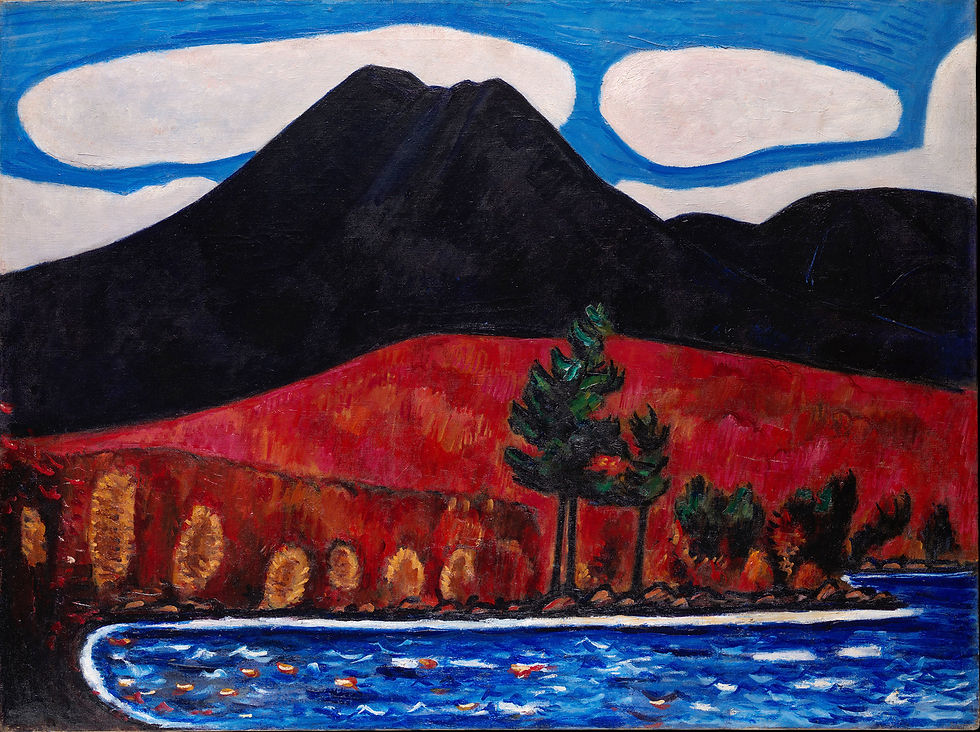Marsden Hartley’s Maine: Mountains and People, Sited and Abstract
- Alessandro Berni

- Mar 29, 2017
- 3 min read
Marsden Hartley’s Maine opens with a floor to ceiling, wall to wall video projection of Maine’s coastline. Waves repeatedly crash against rocks, spraying water in all directions, without audio, a fitting introduction to the artist’s first New York survey since 1980, which features ninety paintings and drawings of Maine. Although his practice took on a variety of subjects over the years, Hartley (b. 1877, Lewiston, ME – d. 1943, Ellsworth, ME) always returned to his home state of Maine, and this exhibition surveys nearly forty years worth of artworks that all hold the state—its coastline, mountains, crops, and inhabitants—as their focal
point.
Organized chronologically, the exhibition begins with two rooms filled with paintings created between 1906 and 1918. While Hartley only intermittently lived in Maine during this time, his paintings from this time period all depict the western border of Maine near the White Mountains, which he painted from memory and from observation during periodic visits. As a result, these paintings have an interesting combination of specificity—as seen in “The Ice Hole, Maine,” a painting of an ice fishing hole cut into one of Maine’s western lakes—and abstraction, a whimsical distortion created with a nostalgic palette—warm blues and purples with highlights of sharp reds, oranges, and greens—and a post-Impressionist application of paint. Also exhibited are four paintings on glass created during a summer at an Ogunquit art colony, including “Still Life (Ear of Corn).” In these, Hartley flattens the space of the image, isolating the crops, flowers, and foliage of the region against smooth black surfaces.

Marsden Hartley, The Ice Hole, Maine, (1908-09), oil on canvas, 34 x 34 in.

Marsden Hartley, Still Life (Ear of Corn), (1917), oil and metal leaf on glass mounted on
board, 20 x 7 ½ in.
The quick, short brushstrokes and energetic palette of these earlier works stand in contrast to a series of paintings — created in New York City in 1909 and revisited in Paris in 1924— that feature darker, more somber colors and smoother, block-like representations of the scenery. Known as the Dark Landscapes, these works extend Hartley’s study of Maine’s rural areas, this time with a moody, ominous twist. For example, in “Paysage,” the layered slopes of the mountains are rendered with chunky, horizontal lines of charcoal gray and black, while the clouds and trees are blotchy and one-dimensional, a signature throughout Hartley’s work.

Marsden Hartley, Paysage, (1924), oil on canvas, 31 7/8 x 31 7/8 in.
Hartley’s practice took another turn in 1937, when he moved back to his home state and set out to become known as “the painter of Maine.” For him, this meant expanding his practice to include not only the coastline, mountains, and natural resources of the area, but also its inhabitants. He painted fisherman, lumberjacks, and hunters with a notably homoerotic emphasis on the male physique. Hartley, who was known to have had several male lovers throughout his life, had an affinity for exaggerating the strength, size, and confidence of his male subjects. In “Canuck Yankee Lumberjack at Old Orchard Beach, Maine,” he pays homage to Cézanne’s “The Bather” (c. 1885). While both paintings feature a man on a beach in a Speedo—with arms on both hips and bodies facing straight ahead—Hartley places a caricature-like emphasis on the man’s muscles; his arms, chest, and legs bulge while his head and facial features recede. The static quality of the pose, and the inclusion of details from Maine’s landscape, is consistent throughout his paintings of the townsfolk.

Marsden Hartley, Canuck Yankee Lumberjack at Old Orchard Beach, Maine, (1940-1), oil on
Masonite-type hardboard, 40 1/8 x 30 in.
The exhibition reaches its conclusion with a series of paintings of Mount Katahdin—the northernmost part of the Appalachian Trail and the highest point in Maine—that Hartley worked on until his death in 1943. After an eight-day trip through the mountains, he completed a dozen paintings that depict them in different seasons. In these paintings, Hartley combines the bright, energetic palette of his earlier works with the block-like, geometric rendering of the elements seen in his Dark Landscapes; he simplifies the compositions to focus on the elements unique to Maine, such as Katahdin’s distinct peak and Baxter State Park’s evergreen trees and lakes, while utilizing a loose interpretation of color and shape. Marsden Hartley’s Maine, organized by Randall R. Griffey of the Met, Elizabeth Finch of Colby College Museum of Art, and Donna M. Cassidy, a professor at the University of Southern Maine, is on view at the Met Breuer through June 18, 2017.

Marsden Hartley, Mount Katahdin (Maine), Autumn #2, (1939), oil on canvas, 30 ¼ x 40 ¼ in.


Comments